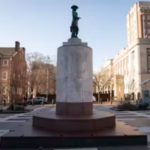By KRISTEN A. GRAHAM
The Philadelphia Inquirer
PHILADELPHIA (AP) _ There is no money for supplies to stock Melissa Holloway’s biology lab, so the teacher at Arts Academy at Benjamin Rush awards extra credit to students who bring in paper towels.
There’s no Latin or Advanced Placement Chemistry at Rush Arts this year, to the disappointment of 180 students who had planned to take those courses.
And if you caught an otherwise excellent student performance in the school theater, you likely squinted, because the staff couldn’t get anyone to fix the lights.
While City Hall and Harrisburg debate funding for the near-destitute Philadelphia School District, students and staff are nearing the end of a school year that has been, in the words of one student, “insane” _ and not in a good way.
Superintendent William R. Hite Jr. said he needs $216 million just to open schools in September at this year’s bare-bones level – no full-time counselors, nurses, and extracurricular activities at many schools. To begin to add more basic supports, he says, he needs $440 million.
Neither sum is assured, and the specter of being in worse straits has been raised: 41-student classes, 1,000 layoffs, opening schools late or closing them early. At those funding levels, officials have said, they cannot ensure students’ safety.
Seen through the lens of one city school, the ramifications of the funding debate are enormous. To contemplate another year under the same circumstances or worse, English teacher Max Feldman said, “that feels like we’re talking about committing a crime.”
Rush, a magnet high school on Knights Road in the Northeast, attracts applications from around the city. It is lucky in many ways _ its pupils rarely cause trouble, and the vast majority go on to college. They are not as needy as the district average, with only 52 percent living in poverty, compared with 87 percent citywide.
But like the 213 other schools in the district, Rush is keeping it together only just barely, leaning heavily on overburdened staff and in some cases teens themselves to keep the school running.
Rush, with 561 students in grades 9 through 12, has lost a counselor, an assistant principal, four teachers, a dean, and an aide this year. Its library is open only sporadically and sits largely empty, because there is no money to buy books.
A group of sophomores decided to research the district’s budget situation for an English project, but in a way, they did not need to; they are living it.
“Classes are much more crowded,” Paul Thiergartner, 16, said through a sign-language interpreter. “We don’t have enough seats. We don’t have enough books. Sometimes we have to share.”
He injured himself in gym class one day, Thiergartner said, but it was not a day the nurse was in the building, so there was no help.
“I just had to wait until the next day,” he said, shrugging.
Daniel Plymouth receives special education services, but this year, those services are harder to come by, the 16-year-old said.
“I’m not getting the help I need,” he said.
Senior Danielle Rosmini loves her advanced biology class and was disappointed when she was told there was no money in the budget for students to tackle dissections. So she and a classmate sold T-shirts, coordinated bake sales, and collected donations from their classmates, raising more than $1,000 to buy cats to dissect.
“It’s insane that we have to raise our own money for basic supplies,” Rosmini said. “We can’t get updated textbooks. We have no money for copy paper, and we need copy paper because there’s no textbooks for us to take home.”
On a recent day, Rosmini’s mentor, Holloway, was in perpetual motion, buzzing from group to group as her Biology 2 class dissected worms – some virtually, through a computer program on a projector.
Holloway, who hangs posters in her classroom reminding students to “Demand evidence and think critically,” has racked up honors for her teaching. But she cannot imagine her long-term future in Philadelphia schools.
“Will I be here 10 years from now? It’s not possible,” Holloway said. “I used all my sick days this year, and I’m not a sick person. I’m spinning my wheels.”
Urban education is her passion, Holloway said. But reading the tea leaves, “I don’t see the Philadelphia School District getting better or more supported in a long-term fix,” she said. “I see a Band-Aid on a bleeding wound, maybe.”
Holloway and other teachers rely on 12th graders who serve as interns, performing clerical tasks, marking papers, and even co-teaching in some instances.
At midday, Sunny Bavaro gulped down her lunch in between helping students complete their “senior manifestos” and figuring out who would give the student speech at graduation. Everything she and other Rush teacher do, Bavaro said, is twofold _ “how do we give the kids the best experience, and how do we make it work since we don’t have enough adults in the building?”
Her mantra to students is “Make it work.”
“In a way, we get to teach valuable skills, but what I resent as a teacher is that grit and resilience are being used as a financial strategy,” Bavaro said.
Rush counselor Susan Senner – a veteran who began working for the district as a secretary straight out of George Washington High School – still feels as if she is catching up, she said during a pause in helping a senior apply for scholarships to help manage the daunting amount of debt she is about to take on as a student at a private university.
Senner and nearly every other counselor in the district were laid off last June. She was called back two months into the school year and laments shortchanging the ninth graders she has been unable to get to know very well and the three seniors who aren’t yet sure what they’re going to do after graduation.
“Other years, I would have met with them multiple times by now, but that’s gone by the wayside,” Senner said. “This has just been a much needier school year, and I don’t know how much more we can do. We just can’t keep up this level of service.”
The school’s projected college attendance rate is 89 percent, officials said – down from 98 percent for the Class of 2013. That troubles Jessica Brown, Rush’s principal. She believes citywide figures will show similar trends.
“Another reason why we need the city and state to fund our schools,” Brown said. “We live in a city surrounded by colleges and universities, and yet we are not investing in our children’s education.”
Veronica Hanley is an avowed Rush booster. She homeschooled some of her six children and sent others to Catholic school. When Rush Arts opened in 2008, she thought she found the perfect fit.
But she is weary, said Hanley, who works as an aide at the school and volunteers as Home and School Association president.
She has noticed that it’s tougher for students to find help when they need it. And she can’t fathom what is on the horizon for her youngest, now a freshman.
“I’m just biding my time – I can’t wait to get out of the school system,” Hanley said.
A mountain of paperwork waited for Brown, the dynamic principal, who rarely has time to sit down. But one of the toughest things for Brown, who will leave Rush soon to become the next principal at the Julia R. Masterman School, is the scant time she is able to spend on her core function: instructional leader.
“Sometimes, I go a couple of days not getting into any classrooms at all,” Brown said. Patrolling the hallways often falls to her, and she and her secretary tag-team as nurses on the three days when Rush has no medical professional in the building.
Against tough odds, Rush still works well. It’s a lively, functional place where students still want to be.
“But we can’t do this again,” Brown said. “We got kids to college this year. But I shudder to think about next year. I can’t tell people that it’s going to be better.”











